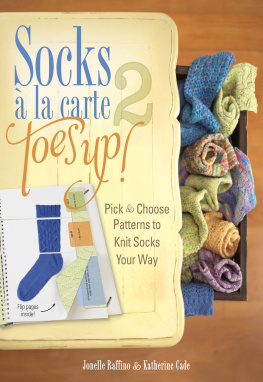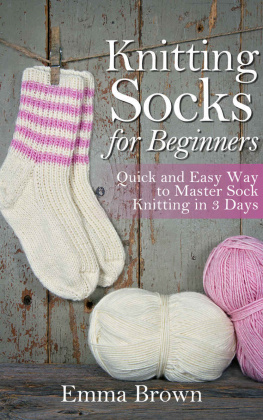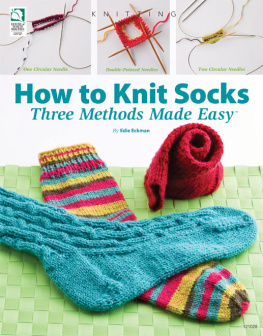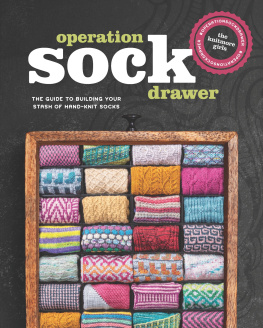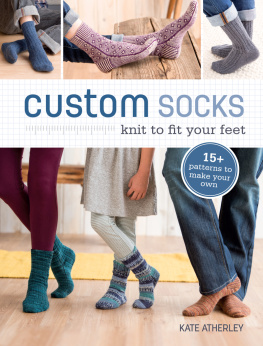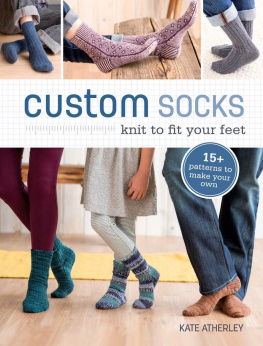
Terrific Toe-Up Socks: Knit to Fit
2011 by Janet Rehfeldt

Martingale
19021 120th Ave. NE, Suite 102
Bothell, WA 98011-9511 USA
ShopMartingale.com
eBook Edition: 2013
No part of this product may be reproduced in any form, unless otherwise stated, in which case reproduction is limited to the use of the purchaser. The written instructions, photographs, designs, projects, and patterns are intended for the personal, noncommercial use of the retail purchaser and are under federal copyright laws; they are not to be reproduced by any electronic, mechanical, or other means, including informational storage or retrieval systems, for commercial use. Permission is granted to photocopy patterns for the personal use of the retail purchaser. Attention teachers: Martingale & Company encourages you to use this book for teaching, subject to the restrictions stated above.
The information in this book is presented in good faith, but no warranty is given nor results guaranteed. Since Martingale & Company has no control over choice of materials or procedures, the company assumes no responsibility for the use of this information.
Library of Congress Cataloging-in-Publication Data is available upon request.
eISBN: 978-1-60468-133-8
Original Source ISBN: 978-1-60468-019-5
Contents
Introduction
Making socks from the toe up remains my favorite way of knitting or crocheting socks. Never fond of finishing work, I love having practically no finishing to do and no grafting of toes. And custom fitting a sock worked from toe to cuff is easier than fitting a sock worked from the cuff downward. For those new to short-row heels, the step-by-step tutorial will have you comfortable with short rows in no time, and toe up may become your favorite method of knitting socks, too.
Ive always strived to give knitters choices, and as in Toe-Up Techniques for Hand-Knit Socks (Martingale & Company, 2008), multiple methods are given for casting on, increasing, working short rows, and binding off. For those who prefer a heel flap and gusset over a short-row heel, step-by-step instructions walk you through a very good version of a reverse heel flap with gusset.
In Terrific Toe-Up Socks, Ive included the Mediterranean (or Turkish) cast on, an afterthought heel, some new and revised illustrations and instructions, and all-new sock designs. I hope you enjoy the technique of knitting your socks from the toe up as much as Ive enjoyed putting this resource together for all you wonderful sock knitters out there. Happy knitting!
Janet Rehfeldt
The Anatomy of Socks
Socks knit from the toe up can be worked with a short-row heel, an afterthought heel, or a heel flap and gusset. And although the afterthought heel and short-row heel are similar, each heel style has a distinctive look.


Before You Begin
Before you dive into the techniques of knitting your socks from the toe up, this section will help you choose yarn and decide what size sock to knit, as well as explain the tools you need (or may want) to make your socks, and the ins and outs of working with double-pointed needles.
SOCK YARNS
Sock yarns are available in a wide variety of fiber and color combinations: solids, stripes, Fair Isle, jacquard, or random effects, with fiber contents such as bamboo, soy, silk, alpaca, wool, cotton, acrylic, and even chitin (fiber derived from the outer skeleton of insects and shrimp and crab shells). And some yarns even pamper us with jojoba and/or aloe vera.
Yarns designed specifically for sock knitting usually contain nylon or polyamide. When using a yarn with no nylon or polyamide content, you may want to knit elastic or Woolly Nylon serger thread into the cuff. If you choose to reinforce the heel and toe area, reinforcement yarn is available in a good color range for knitting together with your sock yarn as you work the heels and toes.
If you have allergies to particular fibers, be sure to check the fiber content on the label, as even some cotton sock yarns may contain wool or other fibers.
When working with self-patterning and striping yarns, be sure to begin each sock with the same color sequence for matching socks.
CHOOSING YOUR SIZE
Toe-up socks are often referred to as knit to fit or until the yarn runs out socks. One of the greatest benefits of knitting toe-up socks is being able to try them on and make adjustments as you knit. You work toe increases to fit at, or just short of, the base of the little toe. The sock foot is knit to just below the anklebone, or 2" to 2 " less than your total foot measurement. After working the heel, you knit the leg and cuff until they reach the length you wantor until you run low on yarn.
To measure a foot for socks (see illustration bellow), first measure the circumference of the foot at, or slightly above, the base of the little toe (A). Measure the circumference of the foot at the widest point (B). Use these measurements to determine when to stop toe increases and if you need to increase at the instep area.
Next, measure the length from the back of the heel to the tip of the longest toe while the person is standing (C). Use this measurement to determine when to begin the heel; work the sock foot portion until its approximately 2" to 2" shorter than the length of your foot.
Hand-knit socks have a degree of stretch, so you do not knit them to the exact circumference and length of the foot. The finished sock foot length should be approximately " to 1" shorter than your foot, and the circumference approximately " to 1" narrower than your foot.
When knitting toe-up socks from a specific pattern with multiple sizes, choose the size closest to your foot circumference. If your foot measurement is between sizes, choose the size providing the fit you want; smaller for a snug fit, wider for a loose fit.

TOOLS
A set of double-pointed needles and some sock yarn will have you well on your way to knitting your socks. However, besides the basic must-haves for your knitting bag, there are some great tools and gadgets on the market that can be helpful.

Double-pointed needles (dpns) come in different lengths, ranging from 3" to 12", in packages of four, five, or six needles. I prefer 6"-long needles for knitting socks, as some of the longer needles can interfere with each other while Im trying to work. I normally work with birch or bamboo needles for wool and wool blends, but prefer coated aluminum needles for cotton. There are also plastic flexible needles that work quite well with most yarns. Use the needles youre most comfortable with, at the length you find the easiest to handle. Although I prefer to knit my socks on double-pointed needles, for those who enjoy working with a single or two circular needles, the techniques in this book will work for you as well.
Next page

